| Article ID | Journal | Published Year | Pages | File Type |
|---|---|---|---|---|
| 8849446 | Natureza & Conservação | 2016 | 9 Pages |
Abstract
Many locally and regionally rare species are not covered by red lists, thus compromising conservation strategies. This is the case with ecotones. After applying three rarity criteria based on both geographic range and on local occurrences to 1755 species of a large transitional zone in South America, we discuss how the priority hierarchy found in the study region can be combined with red books in decision-making to reduce the gaps left by the classification systems adopted by these lists. We point out clear directions about how these species can be used to guide decision making in ecotones, including identifying species of interest for conservation that have not yet been included in red lists, structuring a species group of narrow distribution occurring in areas adjacent to ecological transitions into a hierarchy of priorities for conservation, and using species of the highest hierarchy position in decision making. We believe that the combination of regional lists with national and international red lists is an interesting strategy in the management of species for conservation.
Related Topics
Life Sciences
Agricultural and Biological Sciences
Ecology, Evolution, Behavior and Systematics
Authors
Everton A. Maciel, Ary T. Oliveira-Filho, Pedro V. Eisenlohr,
